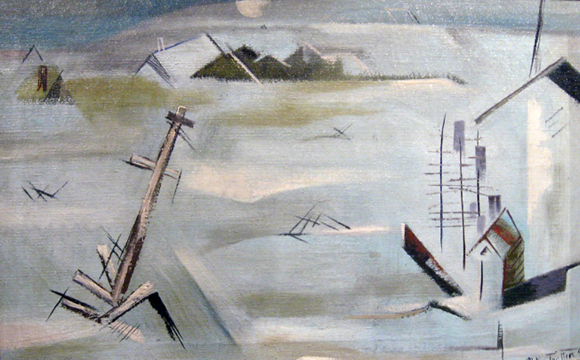 “Flood” by early Fort Worth Modernist McKie Trotter, whose work is on exhibit now in Houston.
“Flood” by early Fort Worth Modernist McKie Trotter, whose work is on exhibit now in Houston.
|
|
A D V E R T I S E M E N T
|
|
|
|
A D V E R T I S E M E N T
|
|
Back Again, At Last
A Houston art gallery celebrates the work of an underrated early
Fort Worth Modernist.
By JEFF PRINCE
Bror Utter, Cynthia Brants, and Kelly Fearing are among the Fort Worth artists usually mentioned first when discussing the city’s early ventures into Modernism. Their reputations and accolades continued throughout their careers. But the work of McKie Trotter, a Fort Worth artist whose impact was overlooked late in his career, is experiencing a renaissance nine years after his death.
The sherry-sipping, classical music-loving, fey artists of the Fort Worth Circle did much to introduce Modern art to Texas in the 1940s, and they got plenty of attention for their efforts. Trotter came along on the heels of those early innovators. But he furthered the Modernist movement throughout the 1950s, and his work is currently being showcased in Houston. McKie Trotter, Back Again At Last continues through Oct. 25 at the William Reaves Fine Art gallery.
Photographs of the paintings and reports from local art enthusiasts who went to see the exhibit suggest the trip is well worth the effort and $3-a-gallon gas.
Trotter became one of the city’s most influential artists and educators after he hit town in 1947 at age 29. He arrived after a stint in World War II that included nine months in a German prisoner of war camp. Trotter began teaching at Texas Wesleyan University in 1948, where he energized local students with his free-spirited brush. He turned the natural landscapes of Texas into forceful abstractions, describing his art as “both real and abstract, with neither side permanently retaining the upper hand.”
Trotter joined the Texas Christian University art department in 1953 and stayed there through the 1980s; he died in 1999 at age 81. Gallery owner William Reaves said Trotter represents the missing link, both as artist and instructor, between the storied old Circle and the newer contemporary generation of Fort Worth artists.
“Trotter is the next logical succession in documenting the story of post-war Fort Worth art,” Reaves said. “Some of the finest Modernist landscapes ever produced in our state were by Trotter.”
Many prominent shows in the 1950s featured Trotter’s work, and the artist even captured the attention of East Coast collectors. In 1956, he was spotlighted in a one-man show at Grand Central Moderns, the modern art division of the Grand Central Art Galleries in Manhattan’s famous terminal.
The Houston exhibit is made up of works from that period. Most of the paintings are owned by the Trotter family and are rarely seen in public, Reaves said. One of the most interesting paintings is the abstract masterpiece Flood, inspired by the May 17, 1949, deluge that washed out much of central Fort Worth and killed 10 people.
Trotter’s works have been included in local shows, including First Light: Local Art and the Fort Worth Library in 2001, but this is the first one-man show in recent memory, said local art enthusiast Morris Matson.
“It’s another one of those situations where out-of-towners recognize the merit of our artists more than we do sometimes,” he said. “It shows how the interest in early Texas art, specifically early Fort Worth art, is spreading.”
More On Early-Texas Art
Closer to home, two other additions to the local art scene are worth investigating. Over in the Stockyards, early-Texas art collector A.C. “Ace” Cook has put up a new batch of paintings at The Bull Ring that are well worth a look. For the past few years, his walls have been covered with the signature pieces of his awe-inspiring Hock Shop Collection. But most of those paintings are currently on display at the Tyler Museum of Art.
“The walls looked pretty bare,” Cook said.
So he reached way back into his nooks, crannies, and closets and pulled out his B-team paintings. Of course, Cook’s second-string collection rivals the holdings of many museums. Check out the 1941 Blanche McVeigh painting featuring an African-American church scene or the 1910 Austin street scene by John Eliot Jenkins or Rolla Taylor’s take on the San Antonio River Walk. Sprinkled among these stalwarts are astounding works by little-known artists.
“This is a random smorgasboard of early-Texas art,” Cook said. “There are things people haven’t seen before, including a really great Harry Kidd piece that he did in 1922 of a señorita while he was in Spain.”
Meanwhile, a portrait of Amon Carter that local artist Scott Gentling spent most of the summer painting is finally on display at the Amon Carter Museum. Carter’s daughter, Ruth Carter Stevenson, commissioned the work by Gentling, a Fort Worth artist whose brilliant portraits over the years prompted Laura Bush to choose him to paint then-Texas Gov. George W. Bush’s official gubernatorial portrait in 2002.
 Email this Article...
Email this Article...

